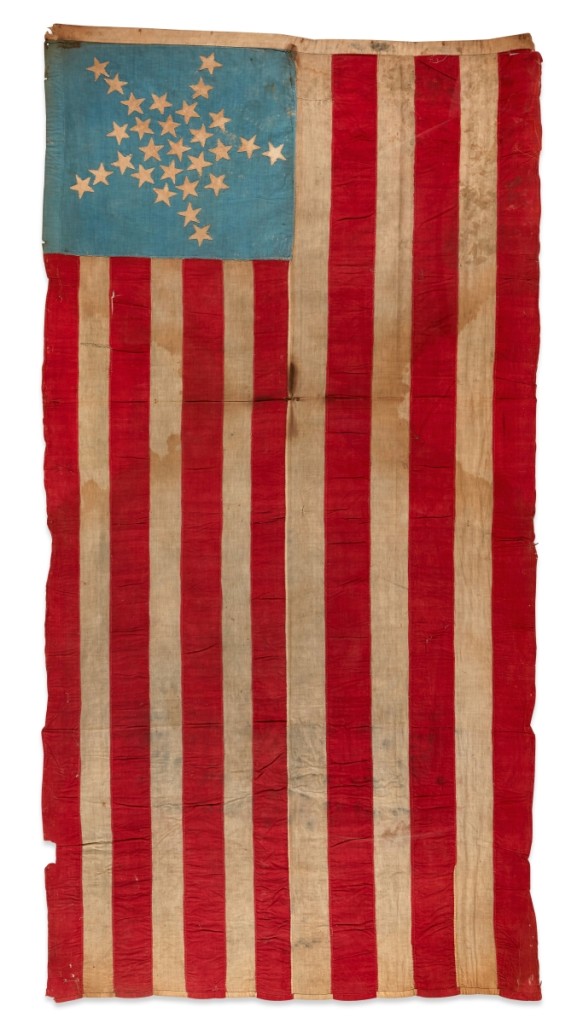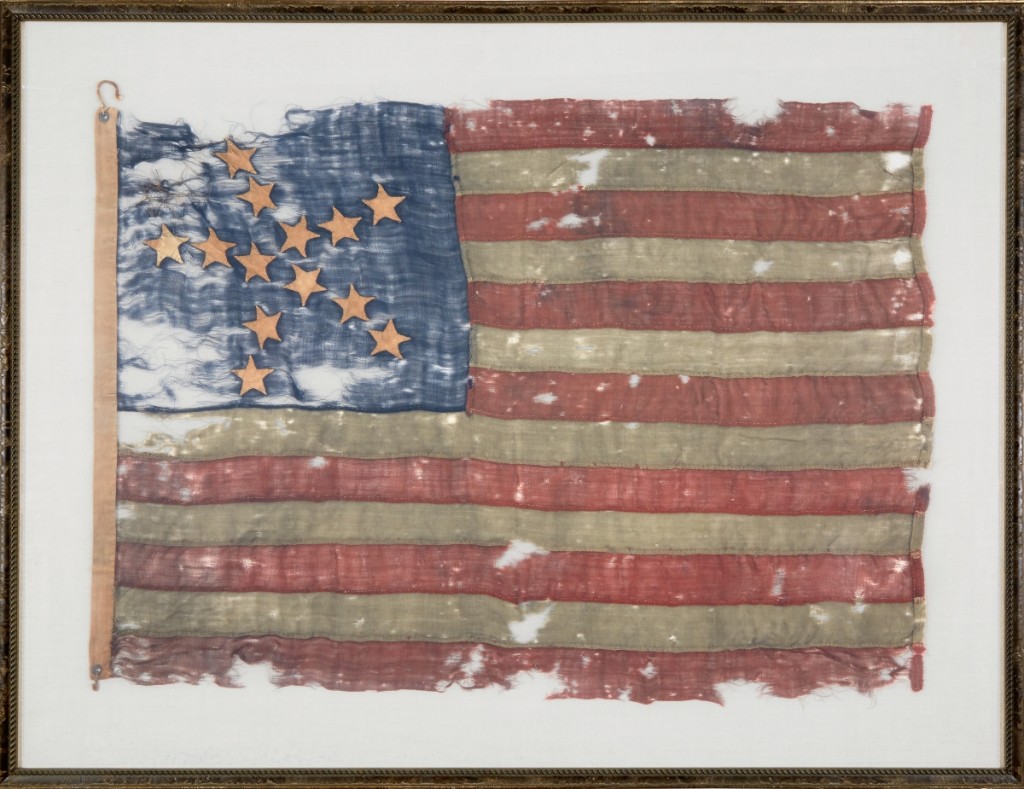
Texas entered the Union in 1845, and this 28-star Great Star American flag commemorating Texas statehood, the top lot in the sale, entered the inventory of Dillsburg, Penn., flag specialist Jeffrey Bridgman, who paid $68,750 for it. Circa 1846, the 52½-by-107-inch example was once in the collection of Jeffrey Kenneth Kohn, MD, who was in the gallery to see it go to a new owner.
Review and Onsite Photos by W.A. Demers, Additional Photos Courtesy of Freeman’s
PHILADELPHIA – As fate would have it, the November 24 sale at Freeman’s – A Grand Old Flag: The Stars & Stripes Collection of Dr Peter J. Keim – which was supposed to inaugurate the firm’s new built-for-the-Twenty-First-Century site at 2400 Market Street – was instead conducted in Freeman’s historic Chestnut Street building because construction delays meant that the new space wouldn’t be available until January. And that turned out to be a good thing.
Two gallery floors at 1808 Chestnut Street, the first and third, were festooned with an incredible and massive display of America’s patriotic textiles, hanging from ceiling to floor, covering the walls, filling display cases, the third-floor stage and all the available niches.
Said Keim afterwards, “I had never seen it [the collection] displayed in its entirety before. Overall, I believe the sale went well, and Freeman’s went well beyond what I’d expected with the way they exhibited the flags in the galleries and presented the collection in the catalog.
“After 45 years of collecting, sharing and caring for Stars and Stripes, I decided to part with my ‘old friends.’ The folks at Freeman’s have been marvelous partners. Their patriotic spirit and respect for the flag was a perfect fit. From day one of planning through the final gavel, it has been a memorable experience. Lynda Cain, Alasdair Nichol, Grace Fitts, Whitney Bounty, Paul Roberts and all the other staff at Freeman’s exceeded my expectations at every step along the way. Fifty Stars!”
“Maybe just because it’s Texas,” quipped Freeman’s chairman Alasdair Nichol as a 28-star Great Star American flag commemorating Texas statehood jumped suddenly from its $9,500 opening to a $25,000 phone bid. “Somebody really wants it,” he observed as bids climbed steadily to a final price of $68,750. The circa 1846 survivor featured hand-sewn, double-appliqued cotton stars in a Great Star pattern, with hand-sewn cotton stripes and a twill cotton hoist with hand-stitched grommet. Mounted and framed, it measured 52½ by 107 inches. It was the top highlight of the 45-year collection of Dr Peter Keim, who was saying goodbye to more than 190 examples of US flags and patriotic ephemera. The Texas flag had been exhibited at the Bullock Texas State History Museum, Austin, and had once been in the collection of Jeffrey Kenneth Kohn, who was in gallery that day to see it off to a new home. Keim preferred to spend the day with his grandchildren.
-1024x647.jpg)
A Western private collector won this 41-star American flag commemorating Montana statehood, circa 1889, for $41,250, ten times its low estimate.
It was not hard to guess that at the other end of one of those phone lines was Jeff Bridgman, noted American flag and Americana dealer from Dillsburg, Penn., who was on a bit of a shopping spree. “I bought the top lot and a back-bid the second highest lot, which was a 41-star flag that I sold to Peter in 2003 for $5,000. It brought $41,250,” said Bridgman after the sale. “At the time, it was the only one I knew to exist in a pieced-and-sewn example. Today, 16 years later, I know of just two others. One of these is institutionalized. The other I own.”
In all, Bridgman’s shopping list totaled a count of 20 lots from the 192-lot sale and the bottom line of dollars spent was $248,313. That represents a sizable chunk of the sale’s gross, which totaled $795,241 and was 79 percent sold by lot. Bridgman and was one of 48 buyers, 15 of which were new to Freeman’s, said Cain.
She said that the flag that got away from Bridgman, the 41-Star American flag commemorating Montana statehood, circa 1889, was won by a Western collector. The machine-sewn flag with double appliqued cotton stars unusually arranged in scattered rows on a two-part wool bunting canton measured 72 by 124 inches. It had been estimated $4/6,000. Montana became the 41st state, November 8, 1889, only six days after the admittance of North Dakota and South Dakota, and was followed three days later by the admittance of Washington state as the 42nd state.
It was not the 13-star flag that Pittsburgh, Penn., collector Keim, first encountered at a farm sale in Kutztown, Penn., some 45 years ago that launched him on his quest. That flag is lovingly enshrined, framed and lit on the wall of the Keims’ home. But the sale did feature a 13-star Great Star pattern American Flag, late Eighteenth/early Nineteenth Century, 30¼ by 43½ inches, which sailed past its $25,000 high estimate and into Bridgman’s inventory for $33,750. Catalog notes state that on June 14, 1777, the Continental Congress in Philadelphia passed the First Flag Resolution, which read, “Resolved That the Flag of the united states be 13 stripes alternate red and white, that the Union be 13 stars white in a blue field representing a new constellation.” No specific proportions, star-form or configuration of stars were given.
Bridgman also captured a 35-star Free Soil Party parade flag, circa 1860, for $31,250. Founded in Buffalo, N.Y., the short-lived Free Soil Party exerted its influence from 1848 to 1854, opposing the expansion of slavery into new territories, but believing that the government could not abolish slavery where it already existed. “Free Soilers” feared and resented the potential competition of a black labor force in the new territories. Highly ironic in the Twenty-First Century, their slogan was “Free soil, Free speech, Free labor and Free men.” Measuring 17 by 22 inches, the printed on glazed cotton design featured stars arranged to create the word “FREE.” This flag exemplified Keim’s evolving collecting approach that he adopted about 20 years in wherein a flag’s “folkiness” in terms of appearance became a factor in its desirability.

On June 14, 1777, the Continental Congress in Philadelphia passed a resolution that stated the flag of the United States would be 13 stripes alternating red and white, and that the Union would be represented by 13 white stars in a blue field. No specific proportions, star-form or configuration of stars were given, leading to many ensuing variations. This 13-star Great Star pattern American flag from the late Eighteenth/early Nineteenth Century arranges the stars in a Great Star formation on a wool bunting canton. It sold for $33,750.
A “Know Nothing” American flag dated 1858 is another such example. Fetching $25,000, the appliqued, printed cotton portrait medallion depicts George Washington below a spreadwing eagle and crossed American flags heightened with 13 embroidered stars and against 17 red cotton stripes hand-sewn to white cotton field, embroidered with the initials, “JWL” and date “Dec 1858.”
The “Know Nothings” were an early nativist American Party that flourished in the United States in the 1850s. The party was founded in 1849, growing out of a reactionary, secret fraternal organization – the Order of the Star-Spangled Banner. Its members were directed to respond that they knew nothing when questioned about their organization. The party was anti-immigration and anti-Roman Catholic and popular enough to claim 43 seats in the Congress of 1855. The Know-Nothings honored George Washington above all else, as demonstrated in the this flag where the canton and stars are replaced with a portrait of the first US president. The 19-by-23¼-inch flag also has a storied provenance, coming from the collection of Boleslaw and Marie-Louise d’Otrange Mastai. A noted husband and wife collecting team, the Mastais, began collecting in the mid-Twentieth Century and amassed one of the greatest private flag collections in the United States.
Part of Peter Keim’s criteria as his collection evolved was to seek flags commemorating various states as they entered the Union. In addition to the Montana flag mentioned previously, there were many such examples parading across the block. Texas, for example, was admitted as the 28th state on December 29, 1845, under President James K. Polk. In addition to the sale’s top lot, there was another 28-star American flag commemorating Texas statehood, also circa 1846, but featuring white stenciled stars, configured in four rows of seven on a four-part cotton canton, with 11 navy blue, red and white stripes, all hand-sewn. Measuring 54 by 121 inches, it sold for $25,000.
The same price was achieved for a 24-star American flag commemorating Missouri statehood, circa 1822. History buffs will recall that Missouri was admitted as a slave state on August 10, 1821, just after Maine joined as a free state, both provided for by the passage of the controversial Missouri Compromise, which sought to maintain the balance of power between the North and the South in the US Senate and also prohibited slavery north of the 36 30′ parallel – excluding Missouri. The legislation is credited to the oratorical and political skills of Speaker of the House Henry Clay. Catalog notes indicate that 24-star flags are rare, especially in this example where the stars are applied on the reverse and “peek” through to the front.
Other flags commemorating statehood status and bringing good prices a 26-star “Great Luminary” American flag for Michigan, circa 1840, $26,250; a 27-star American flag for Florida, circa 1860 (short-lived as Texas was admitted to the Union one year later, $26,250; and a 33-star flag for Oregon, circa 1859, that brought $25,000. This last example had been in the Mastai collection and on its linen hoist was inscribed in ink, “Presented to WM.N. Irvine, by his friend Sarah Downey, 1855.” The Mastais’ commentary on this flag read, “The Irvine Flag consisted originally of 29 stars, valid in 1847; four stars were added later. The first two were inserted without spoiling the design, on the hoist side of the ‘diamond’: they correspond closely in texture and workmanship of the original 29. Indeed, a total of 31 stars would have been proper in 1855. The other two stars, placed haphazardly in the lower-right corner of the canton and less carefully appliqued, must have been added as called for, in 1858 and 1859.”
The flag flown at Fort Sumter with its distinctive “diamond” pattern was surrendered on April 14, 1861, at the start of the Civil War.
Prices given include the buyer’s premium, as stated by the auction house. For information, www.freemansauction.com or 215-563-9275.









.jpg)

.jpg)







.jpg)





